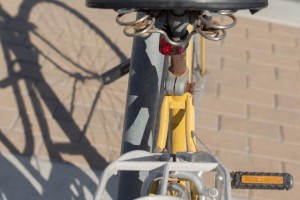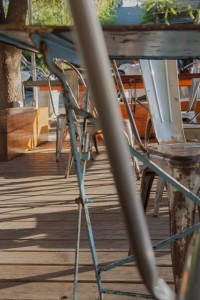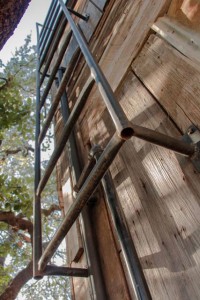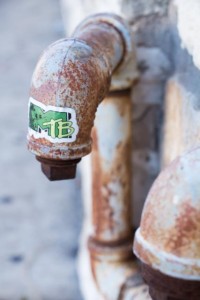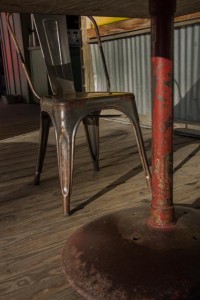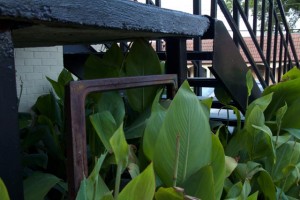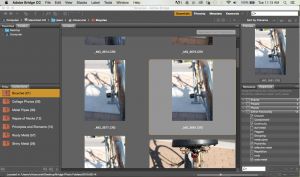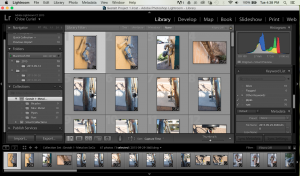Part 1
The first assignment for my Foundation Art & Design class was a photo project in which I had to take 100 photos of one object and create different purposes for the object exist in each compositional frame. I chose a clear container used for desk storage because it had three sliding compartments to hold materials and I knew I could manipulate it and fill it however I wanted to create variation throughout my photos. This object was on my desk holding clothespins and scraps of paper, and I decided that it would be interesting to put other small objects inside the compartments and photograph it in different situations. As I began taking photos, I noticed the unique way light reflected off of the layers of clear plastic and how, in combination with the materials, it distorted the light coming through the plastic, and added dimension to each photograph.
For some of the photos, I put small mementos and meaningful trinkets in each compartment and hung it from a tree to get different perspectives as it rotated and reflected the sun. In others, I experimented with putting LED lights inside and found the reflections and the light that traveled through the container very fascinating. I attempted to display both the functional qualities of the object as well as its adaptable physical qualities. The transparency of the plastic and the way it distorts the objects behind or inside it made it easy to place on a shelf full of color and focus on the refraction of the reality behind the plastic.
I liked that this container was both versatile and rigid in structure, but also that it reminded me of a capsule or a looking glass in which the layers of its contents define it and give it meaning. I felt that these few photographs embodied the reasons why I chose the object, and also captured a tendency I have to create art that is related to preserving memories and building onto the layers of the past that make up our existence.
The purpose of the second assignment in my Foundation Art & Design class was to explore the different uses of line and to get a better understanding of how lines make up everything in the 2D and 3D worlds. As a whole, the project was a process that helped me wrap my mind around thinking about lines as able to create 3D space. I created 75 different representations of lines in a grid format, used lines to create contour drawings of 3D objects, made a 3D sculpture based off of my contour drawings, and then used the shadow of the sculpture to combine the aspects of my process into this one final drawing. My contour drawings and sculpture based on those drawings were of the same tree trunk, so exploring the different ways of representing that tree using only lines was an interesting process.
Throughout the project, I tried to continually focus myself back on the purpose and function of lines, and how planes and space can be created from lines even in a 2D situation. I learned that lines are what decides continuation and texture and form and I tried to convey those qualities, while using a variety of lines to translating the of a 3D aspects of a sculpture into a 2D space.
Part 2
Personal Critique of the Shadow Line Drawing:
1. I think the strongest aspect of this drawing is the definition and detail that the use of different lines brings to the existing shapes. There is also depth created by the negative and positive space that is constituted by the variety of line and materials I used.
2. The weakest aspect of this drawing is, in my opinion, is the craftsmanship and ability to be concise in keeping my work clean.
3.To improve the composition or form of the drawing, I could have used the initial outline of the shadow to create a better plan for the drawing, instead of staying within the confines of the lines I drew on the very first day of working on it. I need to be more open minded when it comes to borders and the open spaces within them in order to not conform to the predictable methods of filling them.
4. Conceptually, this project was fairly lacking. The only concept I was working with in my head while creating this was the translation between 3D objects and their 2D shadows. The sculpture I made was of a tree, so when I traced the shadow, I included my hand holding it up to make a sort of trunk like attachment to the bottom of the paper. I felt that this rooted the branchy tangled apparatus to create a form similar to that of a tree.
5.The project could have been improved technically if I had not ben messy with the pens I was using. The paper I was drawing on had some faint ink smudges and finger prints around the subject. By the time I was done, the surrounding white of the paper looked a little sloppy, and my paper had a few small creases in it by the time it was displayed for critique. I need to work on preserving my work and taking time to make sure it is clean when I present it.





